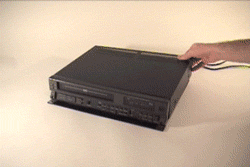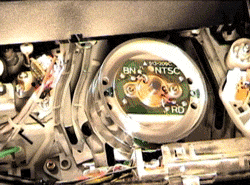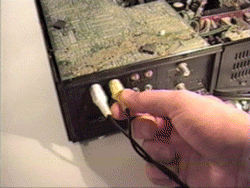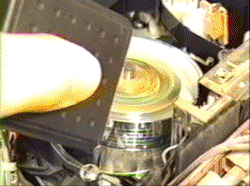Power Mac G4 (1999-2004)

Power Mac G4 (1999-2004)
More Posts from Terminatorstylemilitaryrobots and Others
Why do you need your earbuds to have a wire so badly?
I am assuming this is about a post I reblogged like six months ago when I went off on forced technological enshitification and the slow erosion of consumer options. But sure, I'll bite.
Why do I "need" my earbuds to have a wire? I dunno, Anon, maybe I:
Don't want to have to worry about recharging my earbuds.
Don't want my earbuds to be even easier to lose.
Don't want my earbuds to need separate accessories that are as easy to lose as the earbuds.
Prefer to have bluetooth turned off on my devices for security and safety reasons.
Like being able to seamlessly plug my earbuds into my computer, my MP3 player, or any other device with a headphone jack.
Don't want to spend 50 dollars on decent wireless earbuds when I can do all the above things with a pair of solid earbuds that cost me like $12 during the Obama administration.
Don't care about what kinds of headphones or earbuds people wear but don't like what it says about our society when other people apparently care what kind of earbuds I'm wearing so much they have send an Anonymous ask to interrogate me about it.
And I guess, more abstractly, because fuck Apple. That's why.



A bunch of modelling stuff I made for my partner @kittehburger 's oc Widget!! Isn't he goregous










Heiko Hellwig: Silicon Cities (2017)

What We Learned from Flying a Helicopter on Mars

The Ingenuity Mars Helicopter made history – not only as the first aircraft to perform powered, controlled flight on another world – but also for exceeding expectations, pushing the limits, and setting the stage for future NASA aerial exploration of other worlds.
Built as a technology demonstration designed to perform up to five experimental test flights over 30 days, Ingenuity performed flight operations from the Martian surface for almost three years. The helicopter ended its mission on Jan. 25, 2024, after sustaining damage to its rotor blades during its 72nd flight.
So, what did we learn from this small but mighty helicopter?
We can fly rotorcraft in the thin atmosphere of other planets.
Ingenuity proved that powered, controlled flight is possible on other worlds when it took to the Martian skies for the first time on April 19, 2021.
Flying on planets like Mars is no easy feat: The Red Planet has a significantly lower gravity – one-third that of Earth’s – and an extremely thin atmosphere, with only 1% the pressure at the surface compared to our planet. This means there are relatively few air molecules with which Ingenuity’s two 4-foot-wide (1.2-meter-wide) rotor blades can interact to achieve flight.
Ingenuity performed several flights dedicated to understanding key aerodynamic effects and how they interact with the structure and control system of the helicopter, providing us with a treasure-trove of data on how aircraft fly in the Martian atmosphere.
Now, we can use this knowledge to directly improve performance and reduce risk on future planetary aerial vehicles.

Creative solutions and “ingenuity” kept the helicopter flying longer than expected.
Over an extended mission that lasted for almost 1,000 Martian days (more than 33 times longer than originally planned), Ingenuity was upgraded with the ability to autonomously choose landing sites in treacherous terrain, dealt with a dead sensor, dusted itself off after dust storms, operated from 48 different airfields, performed three emergency landings, and survived a frigid Martian winter.
Fun fact: To keep costs low, the helicopter contained many off-the-shelf-commercial parts from the smartphone industry - parts that had never been tested in deep space. Those parts also surpassed expectations, proving durable throughout Ingenuity’s extended mission, and can inform future budget-conscious hardware solutions.

There is value in adding an aerial dimension to interplanetary surface missions.
Ingenuity traveled to Mars on the belly of the Perseverance rover, which served as the communications relay for Ingenuity and, therefore, was its constant companion. The helicopter also proved itself a helpful scout to the rover.
After its initial five flights in 2021, Ingenuity transitioned to an “operations demonstration,” serving as Perseverance’s eyes in the sky as it scouted science targets, potential rover routes, and inaccessible features, while also capturing stereo images for digital elevation maps.
Airborne assets like Ingenuity unlock a new dimension of exploration on Mars that we did not yet have – providing more pixels per meter of resolution for imaging than an orbiter and exploring locations a rover cannot reach.

Tech demos can pay off big time.
Ingenuity was flown as a technology demonstration payload on the Mars 2020 mission, and was a high risk, high reward, low-cost endeavor that paid off big. The data collected by the helicopter will be analyzed for years to come and will benefit future Mars and other planetary missions.
Just as the Sojourner rover led to the MER-class (Spirit and Opportunity) rovers, and the MSL-class (Curiosity and Perseverance) rovers, the team believes Ingenuity’s success will lead to future fleets of aircraft at Mars.
In general, NASA’s Technology Demonstration Missions test and advance new technologies, and then transition those capabilities to NASA missions, industry, and other government agencies. Chosen technologies are thoroughly ground- and flight-tested in relevant operating environments — reducing risks to future flight missions, gaining operational heritage and continuing NASA’s long history as a technological leader.
You can fall in love with robots on another planet.
Following in the tracks of beloved Martian rovers, the Ingenuity Mars Helicopter built up a worldwide fanbase. The Ingenuity team and public awaited every single flight with anticipation, awe, humor, and hope.
Check out #ThanksIngenuity on social media to see what’s been said about the helicopter’s accomplishments.
Learn more about Ingenuity’s accomplishments here. And make sure to follow us on Tumblr for your regular dose of space!

Jenny Holzer, Arno 1999

What We Learned from Flying a Helicopter on Mars

The Ingenuity Mars Helicopter made history – not only as the first aircraft to perform powered, controlled flight on another world – but also for exceeding expectations, pushing the limits, and setting the stage for future NASA aerial exploration of other worlds.
Built as a technology demonstration designed to perform up to five experimental test flights over 30 days, Ingenuity performed flight operations from the Martian surface for almost three years. The helicopter ended its mission on Jan. 25, 2024, after sustaining damage to its rotor blades during its 72nd flight.
So, what did we learn from this small but mighty helicopter?
We can fly rotorcraft in the thin atmosphere of other planets.
Ingenuity proved that powered, controlled flight is possible on other worlds when it took to the Martian skies for the first time on April 19, 2021.
Flying on planets like Mars is no easy feat: The Red Planet has a significantly lower gravity – one-third that of Earth’s – and an extremely thin atmosphere, with only 1% the pressure at the surface compared to our planet. This means there are relatively few air molecules with which Ingenuity’s two 4-foot-wide (1.2-meter-wide) rotor blades can interact to achieve flight.
Ingenuity performed several flights dedicated to understanding key aerodynamic effects and how they interact with the structure and control system of the helicopter, providing us with a treasure-trove of data on how aircraft fly in the Martian atmosphere.
Now, we can use this knowledge to directly improve performance and reduce risk on future planetary aerial vehicles.

Creative solutions and “ingenuity” kept the helicopter flying longer than expected.
Over an extended mission that lasted for almost 1,000 Martian days (more than 33 times longer than originally planned), Ingenuity was upgraded with the ability to autonomously choose landing sites in treacherous terrain, dealt with a dead sensor, dusted itself off after dust storms, operated from 48 different airfields, performed three emergency landings, and survived a frigid Martian winter.
Fun fact: To keep costs low, the helicopter contained many off-the-shelf-commercial parts from the smartphone industry - parts that had never been tested in deep space. Those parts also surpassed expectations, proving durable throughout Ingenuity’s extended mission, and can inform future budget-conscious hardware solutions.

There is value in adding an aerial dimension to interplanetary surface missions.
Ingenuity traveled to Mars on the belly of the Perseverance rover, which served as the communications relay for Ingenuity and, therefore, was its constant companion. The helicopter also proved itself a helpful scout to the rover.
After its initial five flights in 2021, Ingenuity transitioned to an “operations demonstration,” serving as Perseverance’s eyes in the sky as it scouted science targets, potential rover routes, and inaccessible features, while also capturing stereo images for digital elevation maps.
Airborne assets like Ingenuity unlock a new dimension of exploration on Mars that we did not yet have – providing more pixels per meter of resolution for imaging than an orbiter and exploring locations a rover cannot reach.

Tech demos can pay off big time.
Ingenuity was flown as a technology demonstration payload on the Mars 2020 mission, and was a high risk, high reward, low-cost endeavor that paid off big. The data collected by the helicopter will be analyzed for years to come and will benefit future Mars and other planetary missions.
Just as the Sojourner rover led to the MER-class (Spirit and Opportunity) rovers, and the MSL-class (Curiosity and Perseverance) rovers, the team believes Ingenuity’s success will lead to future fleets of aircraft at Mars.
In general, NASA’s Technology Demonstration Missions test and advance new technologies, and then transition those capabilities to NASA missions, industry, and other government agencies. Chosen technologies are thoroughly ground- and flight-tested in relevant operating environments — reducing risks to future flight missions, gaining operational heritage and continuing NASA’s long history as a technological leader.
You can fall in love with robots on another planet.
Following in the tracks of beloved Martian rovers, the Ingenuity Mars Helicopter built up a worldwide fanbase. The Ingenuity team and public awaited every single flight with anticipation, awe, humor, and hope.
Check out #ThanksIngenuity on social media to see what’s been said about the helicopter’s accomplishments.
Learn more about Ingenuity’s accomplishments here. And make sure to follow us on Tumblr for your regular dose of space!
To be fair, a lot of goofy-sounding rocketry/aerospace terminology has a legitimate nomenclatural role beyond just being silly euphemisms.
"Unplanned rapid disassembly", for example, exists as the necessary counterpart to planned rapid disassembly: sometimes a rocket is legitimately supposed to fall apart or blow up, so you need a specific term to emphasise that it wasn't supposed to do that.
Similarly, "lithobraking" was coined by analogy with aerobraking (shedding velocity via atmospheric friction) and hydrobraking (shedding velocity by landing in water), and it does have some intentional applications; the Mars Pathfinder probe, for example, was deliberately crashed into the Martian surface while surrounded by giant airbags, and reportedly bounced at least 15 times before coming to rest.
(That said, aerospace engineers absolutely do use these terms humorously as well, because engineers are just Like That.)












The video camera is plugged into the VCR, allowing it to record itself being poked and prodded.
GIF’d version of Vide-Uhhh! (2005)

-
 fatherscruffy liked this · 1 day ago
fatherscruffy liked this · 1 day ago -
 misplacedraven reblogged this · 2 days ago
misplacedraven reblogged this · 2 days ago -
 d0nutbuff3r liked this · 2 days ago
d0nutbuff3r liked this · 2 days ago -
 scheming-pangolin reblogged this · 2 days ago
scheming-pangolin reblogged this · 2 days ago -
 frah-g reblogged this · 2 days ago
frah-g reblogged this · 2 days ago -
 frah-g liked this · 2 days ago
frah-g liked this · 2 days ago -
 drinkingcaesars-mp3 liked this · 2 days ago
drinkingcaesars-mp3 liked this · 2 days ago -
 mimzys reblogged this · 2 days ago
mimzys reblogged this · 2 days ago -
 oneeyedsamurai liked this · 2 days ago
oneeyedsamurai liked this · 2 days ago -
 turkeyburgerrrs reblogged this · 2 days ago
turkeyburgerrrs reblogged this · 2 days ago -
 caverica liked this · 2 days ago
caverica liked this · 2 days ago -
 pondus-vitae liked this · 2 days ago
pondus-vitae liked this · 2 days ago -
 theblogoftuesday liked this · 2 days ago
theblogoftuesday liked this · 2 days ago -
 russoull liked this · 2 days ago
russoull liked this · 2 days ago -
 ashthepinkone liked this · 2 days ago
ashthepinkone liked this · 2 days ago -
 dying-fortheknife liked this · 2 days ago
dying-fortheknife liked this · 2 days ago -
 return-of-thepharaoh liked this · 2 days ago
return-of-thepharaoh liked this · 2 days ago -
 shmingleping liked this · 2 days ago
shmingleping liked this · 2 days ago -
 bvby-boyy reblogged this · 2 days ago
bvby-boyy reblogged this · 2 days ago -
 instantlymaximumblaze reblogged this · 2 days ago
instantlymaximumblaze reblogged this · 2 days ago -
 strobilomyces-strobilaceus liked this · 2 days ago
strobilomyces-strobilaceus liked this · 2 days ago -
 taranttulla liked this · 2 days ago
taranttulla liked this · 2 days ago -
 kurotaurus17 liked this · 2 days ago
kurotaurus17 liked this · 2 days ago -
 e-v-i-l-d-e-a-d reblogged this · 2 days ago
e-v-i-l-d-e-a-d reblogged this · 2 days ago -
 dead-2me reblogged this · 2 days ago
dead-2me reblogged this · 2 days ago -
 ecstasy-s-spirit-and-co reblogged this · 2 days ago
ecstasy-s-spirit-and-co reblogged this · 2 days ago -
 larchedenowaypictures liked this · 2 days ago
larchedenowaypictures liked this · 2 days ago -
 saintseraf reblogged this · 2 days ago
saintseraf reblogged this · 2 days ago -
 widegreeneyes reblogged this · 2 days ago
widegreeneyes reblogged this · 2 days ago -
 111104 liked this · 2 days ago
111104 liked this · 2 days ago -
 nitrogen reblogged this · 2 days ago
nitrogen reblogged this · 2 days ago -
 quartzmilk reblogged this · 3 days ago
quartzmilk reblogged this · 3 days ago -
 ink-cartridge-low reblogged this · 3 days ago
ink-cartridge-low reblogged this · 3 days ago -
 blueboyinthestars liked this · 3 days ago
blueboyinthestars liked this · 3 days ago -
 nukkiibunnii liked this · 3 days ago
nukkiibunnii liked this · 3 days ago -
 f1nn-1s-cr4zy liked this · 3 days ago
f1nn-1s-cr4zy liked this · 3 days ago -
 esidisi liked this · 4 days ago
esidisi liked this · 4 days ago -
 rileyjkuehner liked this · 1 week ago
rileyjkuehner liked this · 1 week ago -
 clandestinemeeting reblogged this · 1 week ago
clandestinemeeting reblogged this · 1 week ago -
 meteorswitch reblogged this · 1 week ago
meteorswitch reblogged this · 1 week ago -
 bootloader reblogged this · 1 week ago
bootloader reblogged this · 1 week ago -
 bloggersblogsthings liked this · 1 week ago
bloggersblogsthings liked this · 1 week ago -
 silvermun liked this · 1 week ago
silvermun liked this · 1 week ago -
 shdoaw reblogged this · 1 week ago
shdoaw reblogged this · 1 week ago -
 purplebearworld29 liked this · 2 weeks ago
purplebearworld29 liked this · 2 weeks ago -
 nueska reblogged this · 2 weeks ago
nueska reblogged this · 2 weeks ago -
 kkoralla liked this · 2 weeks ago
kkoralla liked this · 2 weeks ago -
 frankgoji liked this · 2 weeks ago
frankgoji liked this · 2 weeks ago -
 y2kenzie liked this · 2 weeks ago
y2kenzie liked this · 2 weeks ago -
 farimarimoo liked this · 2 weeks ago
farimarimoo liked this · 2 weeks ago
Terminator - Infiltration Configuration Robot
70 posts